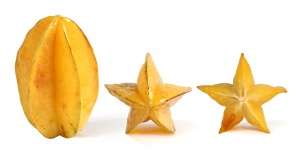Starfruit toxicity
Background

Vertical, end view, and cross section of the ripe carambola "starfuit".
- Starfruit (Averrhoa carambola) is a fruit native to Southeast Asia, but is also grown in South America, the Caribbean, Africa, and the United States
- Can be consumed raw or as juice, jam, pickles, and in cooked dishes
- In traditional Chinese medicine, used to treat diabetes mellitus[1]
Mechanism of Toxicity
- Toxicity caused by two compounds, oxalic acid and caramboxin
- Oxalic acid, a vitamin C metabolite, can worsen renal function but does not cause neurotoxicity
- Caramboxin, an amino acid neurotoxin, stimulates glutamate receptors, which leads to seizures[1]
- Raw fruit has high potassium content while juice does not[2], however hyperkalemia not found in many patients[3][4]
Clinical Features
Differential Diagnosis
Seizure
- Epileptic seizure
- First-time seizure
- Seizure with known seizure disorder
- Status epilepticus
- Temporal lobe epilepsy
- Non-compliance with anti-epileptic medications
- Non-epileptic seizure
- Meningitis
- Encephalitis
- Brain abscess
- Intracranial hemorrhage
- Alcohol withdrawal
- Benzodiazepine withdrawal
- Barbiturate withdrawal
- Baclofen withdrawal
- Metabolic abnormalities: hyponatremia, hypernatremia, hypocalcemia, hypomagnesemia, hypoglycemia, hyperglycemia, hepatic failure, uremia
- Eclampsia
- Neurocysticercosis
- Posterior reversible encephalopathy syndrome
- Impact seizure (head trauma)
- Acute hydrocephalus
- Arteriovenous malformation
- Seizure with VP shunt
- Toxic ingestion (amphetamines, anticholinergics, cocaine, INH, organophosphates, TCA, salicylates, lithium, phenothiazines, bupropion, camphor, clozapine, cyclosporine, fluoroquinolones, imipenem, lead, lidocaine, metronidazole, synthetic cannabinoids, theophylline, Starfruit)
- Psychogenic nonepileptic seizure (pseudoseizure)
- Intracranial mass
- Syncope
- Hyperventilation syndrome
- Migraine headache
- Movement disorders
- Narcolepsy/cataplexy
- Post-hypoxic myoclonus (Status myoclonicus)
Evaluation
- CBC
- Chemistry
- LFTs
- CSF studies
- Urine toxicology
- CT Head without contrast
- EKG
Management
Disposition
- If seizing, admit for monitoring and further workup
- One study showed mortality as high as 75% in seizing patients, 0.03% in patients without seizures[3]
References
- Garcia-Cairasco N. et al. Elucidating the neurotoxicity of the star fruit. Angewandte Chemie (International ed. in English). 2013;52(49):13067-70.
- Chang J. et al. Fatal outcome after ingestion of star fruit (Averrhoa carambola) in uremic patients. American journal of kidney diseases : the official journal of the National Kidney Foundation. 2000;35(2):189-93.
- Tsai M. et al. Status epilepticus induced by star fruit intoxication in patients with chronic renal disease. Seizure. 2005;14(7):521-5.
- Wu M. et al. Hemoperfusion as an effective alternative therapy for star fruit intoxication: A report of 2 cases. American journal of kidney diseases : the official journal of the National Kidney Foundation. 2006;49(1).
- Oliveira de. et al. Why eating star fruit is prohibited for patients with chronic kidney disease? Jornal brasileiro de nefrologia : 'orgao oficial de Sociedades Brasileira e Latino-Americana de Nefrologia. 2015;37(2):241-7.
- Abeysekera R. et al. Star fruit toxicity: A cause of both acute kidney injury and chronic kidney disease: A report of two cases. BMC research notes. 2015;8.
- Neto MM. et al. Star fruit: Simultaneous neurotoxic and nephrotoxic effects in people with previously normal renal function. 2009;2(6).
- Neto M. et al. Intoxication by star fruit (Averrhoa carambola) in 32 uraemic patients: Treatment and outcome. Nephrology, dialysis, transplantation : official publication of the European Dialysis and Transplant Association - European Renal Association. 2002;18(1):120-5.
- Chen L. et al. Chronic renal disease patients with severe star fruit poisoning: Hemoperfusion may be an effective alternative therapy. Clinical toxicology (Philadelphia, Pa.). 2005;43(3):197-9.
- Chan C. et al. Star fruit intoxication successfully treated by charcoal haemoperfusion and intensive haemofiltration. Hong Kong medical journal = Xianggang yi xue za zhi. 2009;15(2):149-52.
- Wu C. et al. Sustained low-efficiency daily diafiltration with hemoperfusion as a therapy for severe star fruit intoxication: A report of two cases. Renal failure. 2001;33(8):837-41.
This article is issued from
Wikem.
The text is licensed under Creative
Commons - Attribution - Sharealike.
Additional terms may apply for the media files.